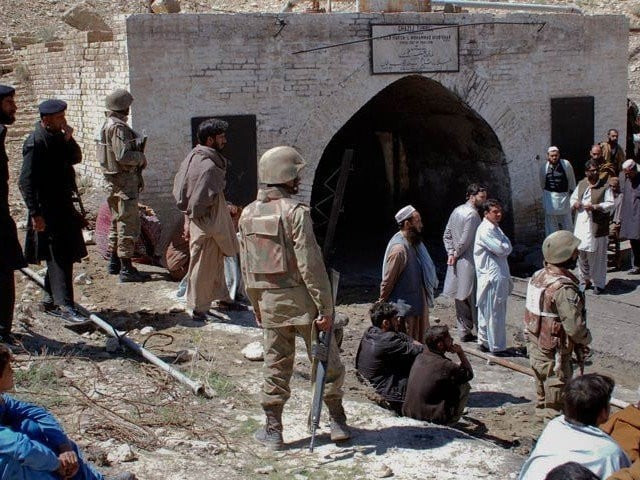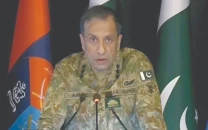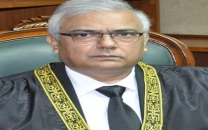Balochistan, K-P dominate violence landscape in first quarter: report
CRSS report indicates remaining regions were relatively peaceful, suffering less than 8% of all fatalities

Pakistan witnessed a total of 432 violence-related fatalities and 370 injuries during the first quarter of 2024, stemming from 245 incidents of terror attacks and counter-terror operations, as revealed in a report released by the Centre for Research and Security Studies (CRSS).
The figure includes 281 fatalities among civilians and security forces personnel.
1711980131-2/CRSS-Q1-Security-Report-(4)1711980131-2.jpeg)
According to the report, the provinces of Khyber-Pakhtunkhwa (K-P) and Balochistan bore the brunt of this violence, accounting for over 92% of all fatalities and 86% of attacks during this period.
The surge in violence, particularly in Balochistan, highlights the escalating challenges faced by security forces in maintaining stability and safeguarding civilian lives, it added.
The report underscores significant regional variations in the intensity of violence, with K-P and Balochistan emerging as epicentres of conflict. While other regions experienced relative peace, with fatalities accounting for less than 8% of the total.
Balochistan experienced a staggering 96% surge in violence during the first quarter of 2024 and fatalities doubled from 91 to 178.
Similarly, Sindh witnessed a nearly 47% rise in violence, albeit with low fatalities. In contrast to the alarming escalation of violence in Balochistan and Sindh, K-P, Punjab, and Gilgit-Baltistan (G-B) recorded significant decreases in violence during the same period.
K-P witnessed a notable 24% decline, signalling progress in the region's security situation. Likewise, Punjab and G-B saw substantial declines of 85% and 65%, respectively, offering hope for improved stability and peace in these areas. However, these positive trends must be sustained through continued vigilance and strategic interventions.
1711980131-1/CRSS-Q1-Security-Report-(3)1711980131-1.jpeg)
Despite the encouraging decrease in violence, G-B faced renewed security concerns, as evidenced by the terror threat alert issued by the G-B home minister. The recent suicide attack on Chinese engineers working on the Dasu Dam project in K-P serves as a sobering reminder of the persistent threat posed by banned militant groups like Tehreek-e-Taliban Pakistan (TTP).
It's worth noting that last year, G-B had suffered the highest number of fatalities in a decade, with 17 lives lost.
The CRSS report highlights the disproportionate impact of violence on civilians and security forces personnel. Civilians and security officials suffered over 65% of all fatalities in nearly 200 terror attacks, compared to outlaws who suffered only 35% in around 48 counter-terror operations.
Among the victims, civilians emerged as the primary targets, bearing the brunt of violence with 154 fatalities, surpassing any other category of victims. This grim reality underscores the devastating impact of terrorism on innocent lives.
1711980131-0/CRSS-Q1-Security-Report-(2)1711980131-0.jpeg)
In the first quarter of 2024, civilians and security forces personnel accounted for over 65% of all fatalities in nearly 200 terror attacks, compared to outlaws who suffered only 35% in around 48 counter-terror operations. The staggering disparity between the number of attacks on civilians and security forces and the limited counter-terror operations against outlaws highlights the asymmetrical nature of the conflict, with innocent civilians disproportionately affected by terrorist violence.
Among the victims, civilians emerged as the primary targets, bearing the brunt of violence with 154 fatalities, surpassing any other category of victims. This grim reality underscores the devastating impact of terrorism on innocent lives.
Comparing the data from the first quarter of 2024 to the preceding quarter reveals a disturbing escalation in violence targeting civilians and security forces. While the combined fatalities of civilians and security officials surged by 17%, fatalities among outlaws, militants, and insurgents combined decreased by almost 15%.
1711980131-3/CRSS-Q1-Security-Report-(1)1711980131-3.jpeg)
Notably, there was a significant increase in the number of insurgent fatalities, skyrocketing by 215%, while militants' fatalities decreased by approximately 33%.
Despite the prevalence of violence, militant organisations surprisingly claimed responsibility for less than 20% of the total casualties attributed to terrorism in the first quarter of the year.
Notably, prominent groups such as Tehreek-e-Jihad Pakistan (TJP), Lashkar-e-Islami (LI), and Lashkar-e-Jhangvi (LeJ), known for their previous activities, refrained from claiming any acts of terrorism during this period.
Instead, groups like TTP and Da’ish emerged as the primary claimants of responsibility, with a new militant group, Jabhat Ansar al-Mahdi Khorasan (JAMK), affiliating with the Gul Bahadur group, making its presence felt.
The absence of claims does not diminish the severity of the situation, as evidenced by the tragic loss of seven security officials, including high-ranking officers, in an unclaimed terror incident in North Waziristan.
Read also: Modern warfare tactics escalating terror threat in K-P
In contrast to the limited claims by militant groups, insurgent organisations such as the Baloch Liberation Army (BLA), Baloch Liberation Front (BLF), Baloch Raji Ajoi Sangar (BRAS), and Sindhudesh Revolutionary Army (SRA) significantly contributed to the violence, claiming responsibility for 18 attacks. These groups targeted security and government installations, posing a persistent threat to stability in the region.
During the first quarter of 2024, there were eight instances of sectarian violence documented, affecting various religious groups, both Muslim and non-Muslim. Ahmadis suffered the most significant losses, with nine casualties, while three fatalities were reported among Shia Muslims as a result of the violence. Furthermore, a Sunni Muslim was also subjected to targeted violence.
The report highlights the complex challenges faced by security forces in combating terrorism and ensuring the safety of citizens. While there has been a notable decrease in violence in some regions, the resurgence of violence in others highlights the need for sustained efforts.



















COMMENTS
Comments are moderated and generally will be posted if they are on-topic and not abusive.
For more information, please see our Comments FAQ